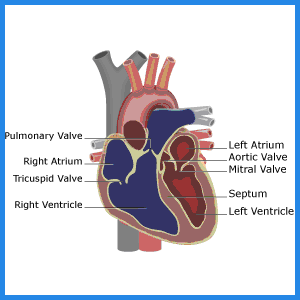Anatomy of the Heart
The female heart weighs about 8 ounces (approximately 2 ounces less than a man’s) and is about the size of a clenched fist. Although it lies in the center of the chest, the bottom of the heart tilts toward the front left side of the chest so it appears to be on the left. The heart is the only muscle in the body that works continuously without needing to rest. It pumps more than 8 pints of blood throughout the female body every minute.

The heart is made up of four chambers. The left atrium and the right atrium on top mainly collect the blood, and the left and right ventricles on the bottom pump the blood. Because the ventricles act as the main pumps for the heart, they are thicker and more muscular than the atria. The left and right sides of the heart are divided by a muscular wall called the septum. The right side of the heart receives oxygen-depleted blood and pumps it to the lungs via the pulmonary artery. The left ventricle pumps oxygen-rich blood out to the body via the aorta; the left ventricle is the main pumping chamber and has thick muscular walls.
Four valves regulate the flow of blood between the heart’s chambers:
- The tricuspid valve regulates the flow of blood from the right atrium to the right ventricle.
- The bicuspid mitral valve regulates the flow of blood between the left atrium and the left ventricle. It is called the mitral valve because it resembles a bishop’s pointy hat, or a miter.
- The pulmonary valve regulates blood flow between the right ventricle and the pulmonary artery (leading to the lungs).
- The aortic valve regulates blood flow from the left ventricle to the aorta.
The valves are pushed open by the force of the blood flow; once the pressure drops, they slam shut like trap doors ensuring the blood flows in one direction only. The lub-dub noise associated with the heartbeat is the sound of the valves opening and shutting.




